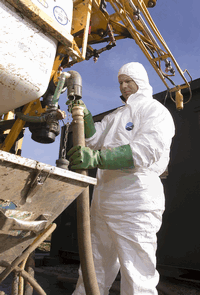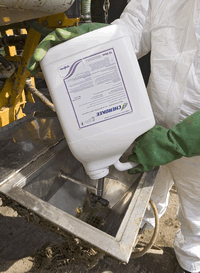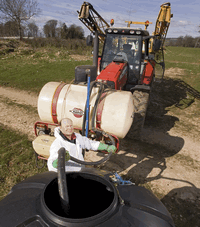Simple solutions for speedier spraying

Typically in the UK, less than a third (28 days) of the key spraying period March to May has suitable weather for spraying, according to Syngenta.
Cutting the amount of time spent filling sprayers, handling containers and travelling between fields and filling area can therefore significantly ease potential bottlenecks, the firm’s trials and applications officer, Ben Magri says.
“With larger acreages and timeliness of products being key, reducing down time is essential.” Work with over 50 growers in Syngenta’s ‘Application Club’ highlighted the sources of downtime (see table) and identified five main areas where time could be saved. “Time savings vary massively between individual farms, but most will be able to do something,” Mr Magri says.
1. Reduce water volumes
Where product labels allow, reducing water volumes from 200 litres/ha to 100 litres/ha allows the sprayer to cover twice as much area between fills, Mr Magri says. “It’s a bit of a contentious issue at the moment, so you need to make sure the label allows 100 litres/ha water, but we’ve shown some fungicides can work as well if not better at this water rate.”
Time saving: 



2. Use low drift nozzles
Fitting low-drift air induction nozzles means growers can spray on windier days than conventional flat fan nozzles and they also allow spraying at increased forward speed, with less chance of drift, says Mr Magri. “You shouldn’t really use ai nozzles on small targets (e.g. small blackgrass in the autumn), but by the time you get to T1, the target – i.e. the crop – is a lot bigger.”
Time saving: 


3. Use ready-formulated products
Instead of mixing separate products, Mr Magri suggests using one pre-formulated product containing the same actives. Wiltshire farmer James Stafford saved 10 minutes per load by using such an approach (see panel) and reckons it can also be a useful way of reducing the number of empty cans to dispose of.
Time saving: 


4. Larger pack sizes
Mr Magri says that using larger cans (eg. 10 litres) is a relatively simple way of saving time at filling, as there are fewer cans to handle, pour, rinse and drain. “Typically a 10 litre can takes about 1min 45secs to empty and wash out, but if you split the same product into constituent parts in separate containers it’s more like four minutes.
“The number of cans per fill has a bigger influence on filling time than product dose per hectare.”
Time saving: 

5. Water and mixer bowsers
Where there is a long distance to travel between field and filling area, water bowsers, or bowsers containing the product ready-mixed can significantly cut the amount of time the sprayer’s not working, Mr Magri says. “One trip with a bowser is better than several time consuming trips with the sprayer back to the yard. We’re talking hours per day that can be saved.”
On one Application Club farm, employing someone to mix products in a separate bowser and take it out to the field saved a third more time, enough to spray an extra 40ha per day. “That was worth about £340 in contractor’s time versus just £17 per hour for the bowser and trained operator,” he says.
If you are using just a water bowser, it may be worth considering adding a chemical locker so that products can be mixed in-field as well, he notes.
“Using a bowser is a very similar approach to what some people do with chaser bins at harvest or when fertiliser spreading or drilling, so why not do it when spraying,” Mr Stafford comments.
Time saving: 



Case study: James Stafford
With (2,400ha) 6000 acres to spray each season (around 500acres of which are on his own farm near Chippenham), ex-Farmer Focus writer, James Stafford, says he cannot afford to waste time on good spray days. “The odd five or 10 minutes saved might not sound that much, but it soon adds up at the end of the day.”
To reduce travelling time to fill up with water, he has five 1500 litre containers plumbed into old cattle troughs around his farm and says that many of the customers he contract sprays for do a similar thing. “The furthest I have to drive to a fill point is probably about 10 minutes, so it makes it a lot easier and quicker.”
Last season he also managed to save enough time to do an extra tank load – equivalent to 17.5ha – after switching from two separate products to one pre-formulated product at T1. “On our own land we used Cherokee (chlorothalonil + cyproconazole + propiconazole) at T1 instead of Opus (epoxiconazole) + Bravo (chlorothalonil) and saved 10 minutes per load, as there was less time spent washing cans and seals.”
Typically, with the “DIY tank mix” Mr Stafford would spend 30 minutes filling-up and do 4-5 loads per day, but with the pre-formulated product, this is reduced to nearer 20 minutes and 5-6 loads, he says. “We’ll go with Cherokee again at T0 this year after last season’s rust problems and probably Opus/ Bravo mix with trace elements at T1.”
Reduced water volumes are used where products allow and so to are air induction nozzles, he notes.
As another way of improving spray capacity, Mr Stafford says he is also replacing his existing 1800 litre Knight mounted-sprayer with a new 3000 litre trailed unit. “It is a bit difficult to get around the whole area with the existing one, so hopefully this will help.”
Approximate time savings
- 1 clock – <5min/load
- 2 clocks – 5-15min/load
- 3 clocks – >15min/load
Example sources of downtime | |
Field to fill point | 4 min |
Pipe on, cans out, lids and foils removed | 6 min |
Chemical in, wash cans & drain | 10 min |
Add remaining water | 3 min |
Farm to field | 4 min |
To tramline and unfold boom | 1.5min |
Total time spray to spray | 29 mins |
